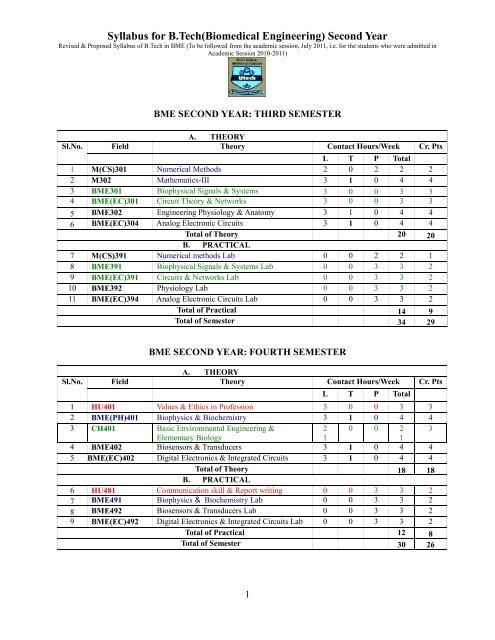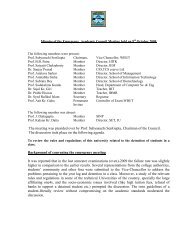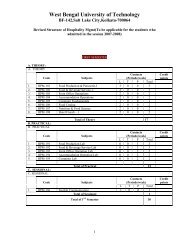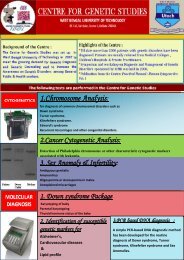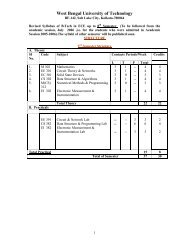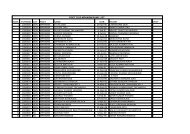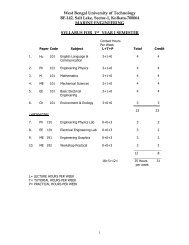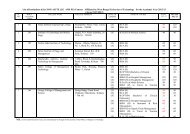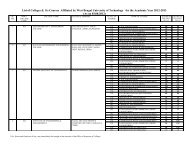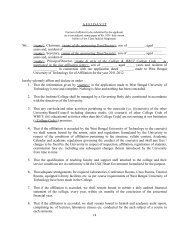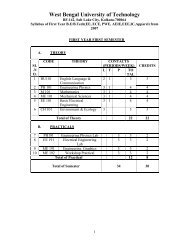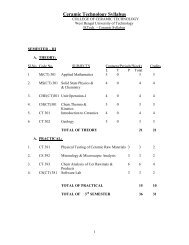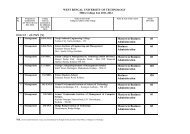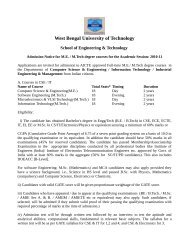Syllabus for B.Tech(Biomedical Engineering) Second Year - WBUT
Syllabus for B.Tech(Biomedical Engineering) Second Year - WBUT
Syllabus for B.Tech(Biomedical Engineering) Second Year - WBUT
You also want an ePaper? Increase the reach of your titles
YUMPU automatically turns print PDFs into web optimized ePapers that Google loves.
<strong>Syllabus</strong> <strong>for</strong> B.<strong>Tech</strong>(<strong>Biomedical</strong> <strong>Engineering</strong>) <strong>Second</strong> <strong>Year</strong><br />
Revised & Proposed <strong>Syllabus</strong> of B.<strong>Tech</strong> in BME (To be followed from the academic session, July 2011, i.e. <strong>for</strong> the students who were admitted in<br />
Academic Session 2010-2011)<br />
Sl.No.<br />
BME SECOND YEAR: THIRD SEMESTER<br />
A. THEORY<br />
Field Theory Contact Hours/Week Cr. Pts<br />
L T P Total<br />
1 M(CS)301 Numerical Methods 2 0 2 2 2<br />
2 M302 Mathematics-III 3 1 0 4 4<br />
3 BME301 Biophysical Signals & Systems 3 0 0 3 3<br />
4 BME(EC)301 Circuit Theory & Networks 3 0 0 3 3<br />
5 BME302 <strong>Engineering</strong> Physiology & Anatomy 3 1 0 4 4<br />
6 BME(EC)304 Analog Electronic Circuits 3 1 0 4 4<br />
Total of Theory 20 20<br />
B. PRACTICAL<br />
7 M(CS)391 Numerical methods Lab 0 0 2 2 1<br />
8 BME391 Biophysical Signals & Systems Lab 0 0 3 3 2<br />
9 BME(EC)391 Circuits & Networks Lab 0 0 3 3 2<br />
10 BME392 Physiology Lab 0 0 3 3 2<br />
11 BME(EC)394 Analog Electronic Circuits Lab 0 0 3 3 2<br />
Total of Practical 14 9<br />
Total of Semester 34 29<br />
Sl.No.<br />
BME SECOND YEAR: FOURTH SEMESTER<br />
A. THEORY<br />
Field Theory Contact Hours/Week Cr. Pts<br />
L T P Total<br />
1 HU401 Values & Ethics in Profession 3 0 0 3 3<br />
2 BME(PH)401 Biophysics & Biochemistry 3 1 0 4 4<br />
3 CH401 Basic Environmental <strong>Engineering</strong> &<br />
2 0 0 2 3<br />
Elementary Biology<br />
1<br />
1<br />
4 BME402 Biosensors & Transducers 3 1 0 4 4<br />
5 BME(EC)402 Digital Electronics & Integrated Circuits 3 1 0 4 4<br />
Total of Theory 18 18<br />
B. PRACTICAL<br />
6 HU481 Communication skill & Report writing 0 0 3 3 2<br />
7 BME491 Biophysics & Biochemistry Lab 0 0 3 3 2<br />
8 BME492 Biosensors & Transducers Lab 0 0 3 3 2<br />
9 BME(EC)492 Digital Electronics & Integrated Circuits Lab 0 0 3 3 2<br />
Total of Practical 12 8<br />
Total of Semester 30 26<br />
1
<strong>Syllabus</strong> <strong>for</strong> B.<strong>Tech</strong>(<strong>Biomedical</strong> <strong>Engineering</strong>) <strong>Second</strong> <strong>Year</strong><br />
Revised & Proposed <strong>Syllabus</strong> of B.<strong>Tech</strong> in BME (To be followed from the academic session, July 2011, i.e. <strong>for</strong> the students who were admitted in<br />
Academic Session 2010-2011)<br />
<strong>Syllabus</strong> <strong>for</strong> B.<strong>Tech</strong> (BME) <strong>Second</strong> <strong>Year</strong><br />
SEMESTER – III<br />
THEORY<br />
NUMERICAL METHODS<br />
Code: M (CS) 301 Contacts: 2L Credits: 2<br />
Approximation in numerical computation: Truncation and rounding errors, Fixed and floating-point arithmetic,<br />
Propagation of errors. (4)<br />
Interpolation: Newton <strong>for</strong>ward & backward interpolation, Lagrange’s and Newton’s divided difference Interpolation.<br />
(5)<br />
Numerical integration: Trapezoidal rule, Simpson’s 1/3 rule, Weddle’s rule. (3)<br />
Numerical solution of a system of linear equations:<br />
Gauss elimination method, Matrix inversion, LU Factorization method, Gauss-Jacobi and Gauss-Seidel iterative<br />
methods.<br />
(6)<br />
Numerical solution of Algebraic equation:<br />
Bisection method, Secant method, Regula-Falsi method, Newton-Raphson method. (4)<br />
Numerical solution of ordinary differential equation: Taylor’s series method, Euler’s method, Runge-Kutta methods,<br />
Predictor-Corrector methods and Finite Difference method. (6)<br />
Text Books:<br />
1. C.Xavier: C Language and Numerical Methods.<br />
2. Dutta & Jana: Introductory Numerical Analysis.<br />
3. J.B.Scarborough: Numerical Mathematical Analysis.<br />
4. Jain, Iyengar , & Jain: Numerical Methods (Problems and Solution).<br />
References:<br />
1. Balagurusamy: Numerical Methods, Scitech.<br />
2. Baburam: Numerical Methods, Pearson Education.<br />
3. N. Dutta: Computer Programming & Numerical Analysis, Universities Press.<br />
4. Soumen Guha & Rajesh Srivastava: Numerical Methods, OUP.<br />
5. Srimanta Pal: Numerical Methods, OUP.<br />
MATHEMATICS-III<br />
Code: M 302 Contacts: 3L +1T Credits: 4<br />
Note 1: The whole syllabus has been divided into five modules.<br />
Note 2: Structure of the question paper<br />
There will be three groups in the question paper. In Group A, there will be one set of multiple choice type questions<br />
spreading the entire syllabus from which 10 questions (each carrying one mark) are to be answered. From Group B,<br />
three questions (each carrying 5 marks) are to be answered out of a set of questions covering all the three modules.<br />
Three questions (each carrying 15 marks) are to be answered from Group C. Each question of Group C will have<br />
2
<strong>Syllabus</strong> <strong>for</strong> B.<strong>Tech</strong>(<strong>Biomedical</strong> <strong>Engineering</strong>) <strong>Second</strong> <strong>Year</strong><br />
Revised & Proposed <strong>Syllabus</strong> of B.<strong>Tech</strong> in BME (To be followed from the academic session, July 2011, i.e. <strong>for</strong> the students who were admitted in<br />
Academic Session 2010-2011)<br />
two or three parts covering not more than two modules. Sufficient questions should to be set covering the whole<br />
syllabus <strong>for</strong> alternatives.<br />
Module I<br />
Fourier Series:<br />
Introduction, Periodic functions, Even and odd functions, Special wave<strong>for</strong>ms, Eulers <strong>for</strong>mulae <strong>for</strong> Fouriers<br />
coefficients, Dirichlet’s conditions and sum of the Fourier series, Half range Fourier series, Parseval’s identity<br />
(Statement only).<br />
Fourier Trans<strong>for</strong>m: Fourier Trans<strong>for</strong>m and its properties, Inverse Fourier Trans<strong>for</strong>m (Statement only), Fourier<br />
Trans<strong>for</strong>m of derivatives (Statement only), Convolution theorem (Statement only). Related problems.<br />
(8L)<br />
Module II<br />
Calculus of Complex variable:<br />
Functions, Limit and Continuity, Analytic functions, Cauchy-Riemann equations<br />
( Statement only) and related problems, Analytic continuation, Complex integration and Cauchy’s theorem<br />
(Statement only), Cauchy’s integral <strong>for</strong>mula ( Statement only), Taylors and Laurent series, Zeros of an analytic<br />
function, Poles, Essential singularities, Residue theorem ( Statement only) and its application to evaluation of<br />
definite integrals (Elementary cases only), Introduction to Con<strong>for</strong>mal Mapping. (12L)<br />
Module III<br />
Probability:<br />
Axiomatic definition of probability, Conditional probability, Independent events, Related problems, Bayes theorem (<br />
Statement only) & its application. One dimensional random variable, Probability distributions-discrete and<br />
continuous, Expectation, Binomial, Poisson, Uni<strong>for</strong>m, Exponential and Normal distribution, Problems on Binomial,<br />
Poisson and Normal distribution only.<br />
(12L)<br />
Module IV<br />
Partial Differential Equations:<br />
Solution of one dimensional wave equation, One dimensional heat-conduction equation, Laplace equation in two<br />
dimension by the methods of<br />
1: Separation of variables 2: Integral Trans<strong>for</strong>ms (Laplace and Fourier Trans<strong>for</strong>ms)<br />
( 6L)<br />
3
<strong>Syllabus</strong> <strong>for</strong> B.<strong>Tech</strong>(<strong>Biomedical</strong> <strong>Engineering</strong>) <strong>Second</strong> <strong>Year</strong><br />
Revised & Proposed <strong>Syllabus</strong> of B.<strong>Tech</strong> in BME (To be followed from the academic session, July 2011, i.e. <strong>for</strong> the students who were admitted in<br />
Academic Session 2010-2011)<br />
Module V<br />
Series solution of Ordinary Differential equation:<br />
Introduction, validity of series solution of an ordinary differential equation, general method to solve equation of the<br />
type: P o y // + P 1 y / +P 2 y = 0, related problems, Bessel’s equation, properties of Bessel’s function, Recurrence <strong>for</strong>mula<br />
<strong>for</strong> Bessel’s function of first kind, Legendre’s equation, Legendre function; Recurrence <strong>for</strong>mula <strong>for</strong> Legendre<br />
function (P n (x)); Orthogonality relation. ( 10L)<br />
Text Books:<br />
1. Brown J.W and Churchill R.V: Complex Variables and Applications, McGraw-Hill.<br />
2. Das N.G.: Statistical Methods, TMH.<br />
3. Grewal B S: Higher <strong>Engineering</strong> Mathematics, Khanna Publishers.<br />
4. James G.: Advanced Modern <strong>Engineering</strong> Mathematics, Pearson Education.<br />
5. Lipschutz S., and Lipson M.L.: Probability (Schaum's Outline Series), TMH.<br />
References:<br />
1. Bhamra K. S.: Partial Differential Equations: An introductory treatment with applications, PHI<br />
2. Dutta Debashis: Textbook of <strong>Engineering</strong> Mathematics, New Age International Publishers.<br />
3. Kreyzig E.: Advanced <strong>Engineering</strong> Mathematics, John Wiley and Sons.<br />
4. Potter M.C, Goldberg J.L and Aboufadel E.F.: Advanced <strong>Engineering</strong> Mathematics, OUP.<br />
5. Ramana B.V.: Higher <strong>Engineering</strong> Mathematics, TMH.<br />
BIOPHYSICAL SIGNALS AND SYSTEMS<br />
Code: BME 301 Contacts: 3L Credits: 3<br />
M# Content Hrs<br />
1 Signals and systems: Continuous time (CT) signals, Discrete time (DT) signals, periodic, aperiodic, 6<br />
random, energy and power signals, step, ramp, impulse and exponential function, Trans<strong>for</strong>mation in<br />
independent variable of signals: time scaling, time shifting and time inverting, classification and properties<br />
of systems, LTI systems - convolution and stability, physiological signals and their properties, Time<br />
invariant and time varying physiological systems.<br />
2 Signal analysis: Basic concepts and development of the Fourier Series, Determination of the Fourier series 6<br />
representation of Continuous and Discrete time periodic signal, Properties of continuous and discrete time<br />
Fourier series, Continuous Time Fourier Trans<strong>for</strong>m (CTFT) and Discrete Time Fourier Trans<strong>for</strong>m (DTFT),<br />
ECG signal analysis.<br />
3 Sampling Theorem and Z-Trans<strong>for</strong>ms: Representation of continuous time signals by its sample, Sampling 6<br />
theorem, Reconstruction of a Signal from its samples, aliasing, Basic principles of z-trans<strong>for</strong>m, z-trans<strong>for</strong>m<br />
definition, Properties of z-trans<strong>for</strong>m, Poles and Zeros, inverse z-trans<strong>for</strong>m.<br />
4 Noise and Feed Back System:: Sources and types of noise, noise factor and temperature, equivalent noise 8<br />
resistance and noise factor in cascade amplifier, Basic Feedback concept, Positive and Negative Feedback,<br />
Sensitivity analysis, Effect of Feedback on disturbance or Noise, Distortion analysis by Feed Back, Control<br />
system, Open loop Control System, Control system With Feed Back, Application of feed back in<br />
physiological systems and its importance.<br />
5 Filtering <strong>Tech</strong>niques: Types of filter (Active and Passive), General idea of L.P.F, H.P.F, B.P.F and N.F.<br />
First order Passive Filters (L.P, H.P, B.P & N.F), First order active filter (L.P, H.P, B.P & N.F), use of filter<br />
<strong>for</strong> biomedical signal analysis, design of filter suitable <strong>for</strong> Bio-medical signal analysis.<br />
4<br />
4
<strong>Syllabus</strong> <strong>for</strong> B.<strong>Tech</strong>(<strong>Biomedical</strong> <strong>Engineering</strong>) <strong>Second</strong> <strong>Year</strong><br />
Revised & Proposed <strong>Syllabus</strong> of B.<strong>Tech</strong> in BME (To be followed from the academic session, July 2011, i.e. <strong>for</strong> the students who were admitted in<br />
Academic Session 2010-2011)<br />
6 Physiological System: Block diagram representation of cardio vascular system, Electrical circuit model of<br />
Blood Pressure, Electrical analog of blood vessels and its transfer function, model of coronary circulation<br />
ant its analysis, Germ, Plasma cell, Antibody, system equation and transfer function. Application of<br />
feedback and block diagram reduction techniques.<br />
Reference Books:<br />
1. Oppenheim, Wilskey and Nawab-Signal & System, Prentice Hall India.<br />
2. Hayken & Van Veen- Signal & System,Willey<br />
3. Taub & Schilling-Principles of Communication System, Tata McGraw Hill.<br />
4. Kennedy & Devis-Electronic Communication System, Tata McGraw Hill<br />
5. Gayakward-Opamps and Linear Integrated Circuits , Prentice Hall India<br />
6. A.K.Sawhney-Electrical & Electronic Measurement & Instrumentation, Dhanpat Rai & Co. (P) Ltd.<br />
4<br />
CIRCUIT THEORY & NETWORKS<br />
Code: BME (EC) 301 Contacts: 3L Credits: 3<br />
M# Content Hrs<br />
1 Resonant Circuits: Series and Parallel Resonance, Impedance and Admittance Characteristics, Quality 4<br />
Factor, Half-Power Points, Bandwidth, Resonant voltage rise, Trans<strong>for</strong>m diagrams, Solution of Problems<br />
2 Mesh Current Network Analysis: Kirchoff’s Voltage Law, Formulation of Mesh Equations, Solution of 6<br />
mesh equations by Cramer’s rule and matrix method, Driving point impedance, Transfer impedance,<br />
Solutions of Problems with DC and AC sources<br />
3 Node Voltage Network Analysis: Kirchoff’s Current Law, Formulation of node equations and solutions, 4<br />
Driving point admittance, Transfer admittance, Solutions of Problems with DC and AC sources<br />
4 Network Theorems: Definition and implications of Superposition Theorem, Thevenin’s Theorem, Norton’s 6<br />
Theorem, Reciprocity Theorem, Compensation Theorem, Maximum Power Transfer Theorem, Millman’s<br />
Theorem, Star-Delta trans<strong>for</strong>mations, Solutions and Problems with DC and AC sources<br />
5 Graph of Network: Concept of Tree Branch, Tree link, junctions, Incident matrix, Tie-set matrix, Cut-set 4<br />
matrix, determination of loop current and node voltages.<br />
6 Coupled Circuits: Magnetic Coupling, polarity of coils, polarity of induced voltage, concept of self and 2<br />
mutual inductance, coefficient of coupling, Solution of Problems<br />
7 Circuit Transients: DC Transient in R-L & R-C circuits with and without initial charge, R-L-C circuits, 4<br />
AC transients in sinusoidal R-L, R-C, & R-L-C circuits, solution of problems<br />
8 Laplace Trans<strong>for</strong>m: Concept of complex frequency, trans<strong>for</strong>mation of f(t) into F(s), trans<strong>for</strong>mation of step, 8<br />
exponential, overdamped surge, critically damped surge, damped sine, undamped sine functions, properties<br />
of Laplace Trans<strong>for</strong>m, linearity, real-differentiation, realintegration, Initial Value Theorem and Final Value<br />
Theorem, Inverse Laplace Trans<strong>for</strong>m, applications in circuit analysis, Partial Fractions expansion,<br />
Heaviside’s Expansion Theorem, solution of problems<br />
9 SPICE: Introduction, model statement, elementary DC and small-signal analysis. 2<br />
Text Books:<br />
1. Valkenburg M. E. Van, Network Analysis, Prentice Hall./Pearson Education<br />
2. Hayt“Engg Circuit Analysis 6/e Tata McGraw-Hill<br />
3. D.A.Bell- Electrical Circuits- Ox<strong>for</strong>d<br />
References:<br />
1. A.B.Carlson-Circuits- Cenage Learning<br />
2. John Bird- Electrical Circuit Theory and <strong>Tech</strong>nology- 3/e- Elsevier (Indian Reprint)<br />
3. Skilling H.H.: “Electrical <strong>Engineering</strong> Circuits”, John Wiley & Sons.<br />
4. Edminister J.A.: “Theory & Problems of Electric Circuits”, McGraw-Hill Co.<br />
5. Kuo F. F., “Network Analysis & Synthesis”, John Wiley & Sons.<br />
6. R.A.DeCarlo & P.M.Lin- Linear Circuit Analysis- Ox<strong>for</strong>d<br />
7. P.Ramesh Babu- Electrical Circuit Analysis- Scitech<br />
5
<strong>Syllabus</strong> <strong>for</strong> B.<strong>Tech</strong>(<strong>Biomedical</strong> <strong>Engineering</strong>) <strong>Second</strong> <strong>Year</strong><br />
Revised & Proposed <strong>Syllabus</strong> of B.<strong>Tech</strong> in BME (To be followed from the academic session, July 2011, i.e. <strong>for</strong> the students who were admitted in<br />
Academic Session 2010-2011)<br />
8. Sudhakar: “Circuits & Networks:Analysis & Synthesis” 2/e TMH<br />
9. M.S.Sukhija & T.K.NagSarkar- Circuits and Networks-Ox<strong>for</strong>d<br />
10. Sivandam- “Electric Circuits and Analysis”, Vikas<br />
11. V.K. Chandna, “A Text Book of Network Theory & Circuit Analysis”,Cyber <strong>Tech</strong><br />
12. Reza F. M. and Seely S., “Modern Network Analysis”, Mc.Graw Hill .<br />
13. M. H. Rashid:Introduction to PSpice using OrCAD <strong>for</strong> circuits and electronics, Pearson<br />
14. Roy Choudhury D., “Networks and Systems”, New Age International Publishers.<br />
15. D.Chattopadhyay and P.C.Rakshit: “Electrical Circuits” New Age<br />
ENGINEERING PHYSIOLOGY & ANATOMY<br />
Code: BME 302 Contacts: 3L +1L Credits: 4<br />
M# Content Hrs<br />
1 Cell: Cell membrane and organelles, Ion channels, Receptors and carriers, Intercellular communication, 8<br />
Membrane potential, Action Potential, Generation and Conduction, Blood Cells, Origin of RBC, structure<br />
and function of haemoglobin, Plasma proteins, Bone marrow, Hematocrit, ESR and its significance, Blood<br />
volume regulation, blood coagulation and factors, Bleeding and clotting time, immunity and antibodies,<br />
Blood Groups and blood transfusion.<br />
2 Muscular & Nervous System: Type of muscles and functional differences, Electron microscopic structure 8<br />
of skeletal muscle, Salient properties of muscles (excitability and contractility, all or none law, refractory<br />
period, fatigue and elasticity), Muscles as energy transducer, Muscle contraction (E-C coupling<br />
mechanism), Structure and function of neurons, Electrical potentials (Generator & receptor), Nerve<br />
conduction, synapse and properties, synaptic transmission, neurotransmitters, motor unit, Neuromuscular<br />
junction, receptors and reflex arc, Brain, spinal cord.<br />
3 Cardiac & Respiratory System: Structure of heart and role as pump, Major blood vessels, ultra structure 10<br />
of blood vessels, Heart valves, Special junctional tissues of heart, heart sounds, Cardiac cycle, Cardiac<br />
output, Coronary and peripheral circulation, Nerve control of heart, Blood Pressure, Feedback Control <strong>for</strong><br />
Blood Pressure, Respiratory pathways (upper and lower), Mechanism of respiration, respiratory membrane<br />
and gaseous exchange, feedback control mechanism of respiration.<br />
4 Digestive & Excretory System: Organisation of GI System, Digestion and absorption, Movements of GI 6<br />
tract, Intestine, Liver, Pancreas, Structure of Nephron, Mechanism of Urine <strong>for</strong>mation, Urine Reflex, Skin<br />
and Sweat Gland, Temperature regulation.<br />
5 Eye, Ear & Endocrine Glands: Optics of Eye, Retina, Photochemistry of Vision, Neuro-physiology of 4<br />
vision, Accommodation, Physiology of middle and internal ear, Auditory Pathway, Mechanism of Hearing,<br />
Endocrine glands.<br />
6 Skeletal System & Joints: Types of bones, classification, Structure and composition of bone, mechanical 4<br />
and electrical properties of bone, blood supply, Cartilage, tendon, ligament, Classification of joints, structure<br />
of synovial joint, major joints of the limbs and Temporomandibular joint.<br />
Reference Books:<br />
1. Essential of Medical Physiology - Anil Baran Singha Mahapatra, Current Books International<br />
2. Human Physiology - C.C.Chatterjee, Medical Allied Agency<br />
3. Text book of Medical Physiology- Guyton<br />
4. Concise Medical Physiology - Chauduri<br />
5. Anatomy and Physiology – Ross & Wilson, Churchill Livigstone publications.<br />
6. Modern Physiology & Anatomy <strong>for</strong> Nurses - J Gibson, Black-well Scientific Publishers<br />
6
<strong>Syllabus</strong> <strong>for</strong> B.<strong>Tech</strong>(<strong>Biomedical</strong> <strong>Engineering</strong>) <strong>Second</strong> <strong>Year</strong><br />
Revised & Proposed <strong>Syllabus</strong> of B.<strong>Tech</strong> in BME (To be followed from the academic session, July 2011, i.e. <strong>for</strong> the students who were admitted in<br />
Academic Session 2010-2011)<br />
ANALOG ELECTRONIC CIRCUITS<br />
Code: BME (EC) 304 Contacts: 3L +1L Credits: 4<br />
M# Content Hrs<br />
1 Filters and Regulators: Capacitor filter, π-section filter, ripple factor, series and shunt voltage regulator, 4<br />
percentage regulation, 78xx and 79xx series, concept of SMPS.<br />
2 Transistor Biasing and Stability: Q-point, Self Bias-CE, Compensation techniques, h-model of transistors. 6<br />
Expression <strong>for</strong> voltage gain, current gain, input and output impedance, trans-resistance & transconductance;<br />
Emitter follower circuits, High frequency model of transistors.<br />
3 Transistor Amplifiers: RC coupled amplifier, functions of all components, equivalent circuit, derivation of 6<br />
voltage gain, current gain, input impedance and output impedance, frequency response characteristics, lower<br />
and upper half frequencies, bandwidth, and concept of wide band amplifier.<br />
4 Feedback Amplifiers & Oscillators: Feedback concept, negative & positive feedback, voltage/ current, 4<br />
series/shunt feedback, Berkhausen criterion, Colpitts, Hartley’s, Phase shift, Wein bridge and crystal<br />
oscillators.<br />
5 Operational Amplifier: Ideal OPAMP, Differential Amplifier, Constant current source (current mirror 6<br />
etc.), level shifter, CMRR, Open & Closed loop circuits, importance of feedback loop (positive & negative),<br />
inverting & non-inverting amplifiers, voltage follower/buffer circuit.<br />
6 Applications of Operational Amplifiers: adder, integrator & differentiator, comparator, Schmitt Trigger. 6<br />
Instrumentation Amplifier, Log & Anti-log amplifiers, Trans-conductance multiplier, Precision Rectifier,<br />
voltage to current and current to voltage converter, free running oscillator.<br />
7 Power amplifiers – Class A, B, AB, C, Conversion efficiency, Tuned amplifier 4<br />
8 Multivibrator:Monostable, Bistable,Astable multivibrators; Monostable and astable operation using 555 2<br />
timer.<br />
9 Special Functional Circuits: VCO and PLL. 2<br />
Text Books:<br />
1. Sedra & Smith-Microelectronic Circuits- Ox<strong>for</strong>d UP<br />
2. Franco—Design with Operational Amplifiers & Analog Integrated Circuits,3/e,McGraw Hill<br />
3. Boylested & Nashelsky- Electronic Devices and Circuit Theory- Pearson/PHI<br />
References:<br />
1. Millman & Halkias – Integrated El;ectronics, McGraw Hill.<br />
2. Rashid-Microelectronic Circuits-Analysis and Design- Thomson (Cenage Learning)<br />
3. Schilling & Belove—Electronic Circuit:Discrete & Integrated , 3/e , McGraw Hill<br />
4. Razavi- Fundamentals of Microelectronic s- Wiley<br />
5. Malvino—Electronic Principles , 6/e , McGraw Hill<br />
6. Horowitz & Hill- The Art of Electronics; Cambridge University Press.<br />
7. Bell- Operational Amplifiers and Linear ICs- Ox<strong>for</strong>d UP<br />
8. Tobey & Grame – Operational Amplifier: Design and Applications, Mc GrawHill.<br />
9. Gayakwad R.A -- OpAmps and Linear IC’s, PHI<br />
10. Coughlin and Driscol–Operational Amplifier and Linear Integrated Circuits–Pearson Edn<br />
7
<strong>Syllabus</strong> <strong>for</strong> B.<strong>Tech</strong>(<strong>Biomedical</strong> <strong>Engineering</strong>) <strong>Second</strong> <strong>Year</strong><br />
Revised & Proposed <strong>Syllabus</strong> of B.<strong>Tech</strong> in BME (To be followed from the academic session, July 2011, i.e. <strong>for</strong> the students who were admitted in<br />
Academic Session 2010-2011)<br />
PRACTICAL<br />
NUMERICAL METHODS LABORATORY<br />
Code : M(CS) 391 Contacts: 2P Credits :1<br />
1. Assignments on Newton <strong>for</strong>ward & backward, Lagrange’s interpolation.<br />
2. Assignments on numerical integration using Trapezoidal rule, Simpson’s 1/3 rule, Weddle’s rule.<br />
3. Assignments on numerical solution of a system of linear equations using Gauss elimination, Matrix inversion,<br />
Gauss-Jacobi, and Gauss-Seidel iterations.<br />
4. Assignments on numerical solution of Algebraic Equation by Bisection, Secant, Regular-falsi and Newton<br />
Raphson methods.<br />
5. Assignments on ordinary differential equation: Taylor series, Euler’s, Runga-Kutta and Finite difference<br />
methods.<br />
6. Introduction to Software Packages: Matlab / Scilab / Labview / Mathematica.<br />
BIOPHYSICAL SIGNALS & SYSTEMS LABORATORY<br />
Code : BME 391 Contacts: 3P Credits :2<br />
The following simulation exercise should be carried out in MATLAB or C programming.<br />
1. Familiarization with MATLAB and generation of various types of wave<strong>for</strong>ms (sine, cosine, square,<br />
triangular etc.).<br />
2. Generation of different functions (unit impulse, unit step, RAMP, etc.)<br />
3. Find out the signal energy and power<br />
4. Generation of various types of noise (uni<strong>for</strong>m white, Gaussian, coloured etc.).<br />
5. Analysis CTFT & DTFT<br />
6. To study Z- trans<strong>for</strong>m of: a) Sinusoidal signals b) Step functions.<br />
7. To study LPF &HPF, band pass and reject filters using RC circuits<br />
8. ECG signal analysis / Equivalent electrical circuit analysis of blood vessels<br />
CIRCUITS & NETWORKS LABORATORY<br />
Code : BME(EC) 391 Contacts: 3P Credits :2<br />
1. Characteristics of Series & Parallel Resonant circuits<br />
2. Verification of Network Theorems<br />
3. Transient Response in R-L & R-C Networks ; simulation / hardware<br />
4. Transient Response in RLC Series & Parallel Circuits & Networks; simulation / hardware<br />
5. Determination of Impedance (Z), and Admittance (Y) parameters of Two-port networks<br />
6. Generation of periodic, exponential, sinusoidal, damped sinusoidal, step, impulse, and ramp signals using<br />
MATLAB<br />
7. Representation of Poles and Zeros in s-plane, determination of partial fraction expansion in s-domain and<br />
cascade connection of second-order systems using MATLAB<br />
8. Determination of Laplace Trans<strong>for</strong>m, different time domain functions, and Inverse Laplace Trans<strong>for</strong>mation<br />
using MATLAB<br />
Note: An Institution / college may opt <strong>for</strong> some other hardware or software simulation wherever possible in place of<br />
MATLAB<br />
8
<strong>Syllabus</strong> <strong>for</strong> B.<strong>Tech</strong>(<strong>Biomedical</strong> <strong>Engineering</strong>) <strong>Second</strong> <strong>Year</strong><br />
Revised & Proposed <strong>Syllabus</strong> of B.<strong>Tech</strong> in BME (To be followed from the academic session, July 2011, i.e. <strong>for</strong> the students who were admitted in<br />
Academic Session 2010-2011)<br />
PHYSIOLOGY LABORATORY<br />
Code : BME 392 Contacts: 3P Credits :2<br />
1. Identification of histological slides – nerve tissues (cerebellum, cerebral cortex, neurons, spinal cord, nodes<br />
of Ranvier, corneal cell space), renal tissues. Blood vessels (artery & vein), skin, tongue, liver.<br />
2. Blood film making & identification of different blood corpuscles.<br />
3. Measurement of TC of RBC & WBC & DC of WBC.<br />
4. Determination of ESR<br />
5. Determination of BT, CT<br />
6. Determination of Blood Group ( ABO; Rh).<br />
7. Hemoglobin estimation<br />
8. Determination of blood pressure<br />
ANALOG ELECTRONIC CIRCUITS LABORATORY<br />
Code : BME(EC) 394 Contacts: 3P Credits :2<br />
1. Study of Diode as clipper & clamper<br />
2. Study of Zener diode as a voltage regulator<br />
3. Study of ripple and regulation characteristics of full wave rectifier without and with capacitor filter<br />
4. Study of characteristics curves of B.J.T & F.E.T .<br />
5. Construction of a two-stage R-C coupled amplifier & study of it’s gain & Bandwidth.<br />
6. Study of class A & class B power amplifiers.<br />
7. Study of class C & Push-Pull amplifiers.<br />
8. Realization of current mirror & level shifter circuit using Operational Amplifiers.<br />
9. Study of timer circuit using NE555 & configuration <strong>for</strong> monostable & astable multivibrator.<br />
10. Construction & study of Bistable multivibrator using NE 555.<br />
11. Study of Switched Mode Power Supply & construction of a linear voltage regulator using regulator IC chip.<br />
12. Construction of a simple function generator using IC.<br />
13. Realization of a V-to-I & I-to-V converter using Op-Amps.<br />
14. Realization of a Phase Locked Loop using Voltage Controlled Oscillator (VCO).<br />
15. Study of D.A.C & A.D.C.<br />
9
<strong>Syllabus</strong> <strong>for</strong> B.<strong>Tech</strong>(<strong>Biomedical</strong> <strong>Engineering</strong>) <strong>Second</strong> <strong>Year</strong><br />
Revised & Proposed <strong>Syllabus</strong> of B.<strong>Tech</strong> in BME (To be followed from the academic session, July 2011, i.e. <strong>for</strong> the students who were admitted in<br />
Academic Session 2010-2011)<br />
SEMESTER – IV<br />
THEORY<br />
VALUES & ETHICS IN PROFESSION<br />
Code: HU 401 Contacts: 3L Credits: 3<br />
Science, <strong>Tech</strong>nology and <strong>Engineering</strong> as knowledge and as Social and Professional Activities<br />
Effects of <strong>Tech</strong>nological Growth:<br />
Rapid <strong>Tech</strong>nological growth and depletion of resources, Reports of the Club of Rome. Limits of growth: sustainable<br />
development<br />
Energy Crisis: Renewable Energy Resources<br />
Environmental degradation and pollution. Eco-friendly <strong>Tech</strong>nologies. Environmental Regulations, Environmental<br />
Ethics<br />
Appropriate <strong>Tech</strong>nology Movement of Schumacher; later developments<br />
<strong>Tech</strong>nology and developing notions. Problems of <strong>Tech</strong>nology transfer, <strong>Tech</strong>nology assessment impact analysis.<br />
Human Operator in <strong>Engineering</strong> projects and industries. Problems of man, machine, interaction, Impact of assembly<br />
line and automation. Human centered <strong>Tech</strong>nology.<br />
Ethics of Profession:<br />
<strong>Engineering</strong> profession: Ethical issues in <strong>Engineering</strong> practice, Conflicts between business demands and<br />
professional ideals. Social and ethical responsibilities of <strong>Tech</strong>nologists. Codes of professional ethics. Whistle<br />
blowing and beyond, Case studies.<br />
Profession and Human Values:<br />
Values Crisis in contemporary society<br />
Nature of values: Value Spectrum of a good life<br />
Psychological values: Integrated personality; mental health<br />
Societal values: The modern search <strong>for</strong> a good society, justice, democracy, secularism, rule of law, values in Indian<br />
Constitution.<br />
Aesthetic values: Perception and enjoyment of beauty, simplicity, clarity<br />
Moral and ethical values: Nature of moral judgements; canons of ethics; ethics of virtue; ethics of duty; ethics of<br />
responsibility.<br />
Books:<br />
1. Stephen H Unger, Controlling <strong>Tech</strong>nology: Ethics and the Responsible Engineers, John Wiley & Sons, New<br />
York 1994 (2 nd Ed)<br />
2. Deborah Johnson, Ethical Issues in <strong>Engineering</strong>, Prentice Hall, Englewood Cliffs, New Jersey 1991.<br />
3. A N Tripathi, Human values in the <strong>Engineering</strong> Profession, Monograph published by IIM, Calcutta 1996.<br />
10
<strong>Syllabus</strong> <strong>for</strong> B.<strong>Tech</strong>(<strong>Biomedical</strong> <strong>Engineering</strong>) <strong>Second</strong> <strong>Year</strong><br />
Revised & Proposed <strong>Syllabus</strong> of B.<strong>Tech</strong> in BME (To be followed from the academic session, July 2011, i.e. <strong>for</strong> the students who were admitted in<br />
Academic Session 2010-2011)<br />
BIOPHYSICS & BIOCHEMISTRY<br />
Code: BME(PH) 401 Contacts: 3L+1T Credits: 4<br />
M# Content Hrs<br />
1 Biological principles: Composition & properties of the cell membrane, membrane transports, 8<br />
permeability Coefficient & partition coefficient, body fluids, electrolytes, acid-base balance, blood<br />
viscosity and Newtonian nature, colloids, filtration, diffusion, osmosis, dialysis, ultrafiltration,<br />
ultracentrifugation, cellular fractionation, electrophoresis, plasmapherosis, radioimmunoassay,<br />
Photochemical reaction, law of photochemistry, fluorescence and phosphorescence.<br />
2 Bioelectricity: Membrane Potential, Local and propagator types, Diffusion potential, phase boundary 8<br />
potentials, Generator Potentials, compound Action Potentials (AP), Propagation of AP, factors influencing<br />
propagation of AP, biosignal and types, Electrical properties of excitable membranes, Membrane<br />
Capacitance, Resistance, conductance, dielectric properties of membrane, space and time constant <strong>for</strong><br />
excitable membrane, equivalent electrical circuit diagram <strong>for</strong> excitable membranes and neural<br />
membranes.<br />
3 Electrical stimulus & Biophysical activity: Stimuli, Receptor potential, pacemaker potential, strengthduration<br />
8<br />
relationship, skin impedance, total body impedance, impedances at high frequencies, patient<br />
safety, electrical shock and hazards, leakage current, Electrical activity of brain (EEG), different wave<br />
<strong>for</strong>ms & their characteristics, Electrical activity of heart (ECG), wave<strong>for</strong>m and significance, Electrical<br />
activity of muscles (EMG) and muscle tone, Electro-RetinoGram(ERG), Electro-Occologram (EOG)<br />
4 Radioactivity: Ionizing radiations, U-V & I-R radiations, Production of radioisotopes & their use in 4<br />
biomedical research, Radioactive decays, Half life period, Linear Energy Transfers (LET), Relative<br />
Biological Efficiency (RBE) and Interaction of radiation with-matter<br />
5 Macromolecules: Classification and functions of carbohydrates, glycolysis, TCA cycle, ATP sysnthesis, 8<br />
Blood Sugar analysis and glucose tolerance test, Classification and functions of proteins, architecture of<br />
proteins, Classification of amino acids, Oxidative and non oxidative deamination, transamination,<br />
decarboxylation, urea cycle, Purification/separation of proteins, Classification and functions of lipids,<br />
biosynthesis of long chain fatty acids, oxidation and degradation of fatty acids.<br />
6 Enzymes and Nucleic acids: Chemical nature and broad classification of enzymes, M-M-Kinetics, 4<br />
Isozymes and Allosteric enzymes, Isolation techniques, Structure of DNA, Genetic code, Recombinant<br />
DNA, Transcription & Translation, Reverse Transcription, Replication.<br />
Reference Books:<br />
1. Radiation Biophysics, <strong>Second</strong> Edition - by Edward L. Alpen - Academic Press; 2 edition<br />
2. Bio-Physics – Roland Glaser- Springer; 2nd printing edition (November 23, 2004)<br />
3. Text book of Medical Physiology- Guyton<br />
4. The <strong>Biomedical</strong> <strong>Engineering</strong> Hand Book- 3 rd Ed- (<strong>Biomedical</strong> <strong>Engineering</strong> Fundamentals) - Joseph D.<br />
Bronzino – CRC –Tylor-Francis – 2006 (Section- III – Bio-Electrical Phenomena)<br />
5. Lehninger Principles of Biochemistry, Fourth Edition - by David L. Nelson & Michael M.Cox , - W. H.<br />
Freeman; 4 edition (April 23, 2004)<br />
6. Fundamentals of Biochemistry: Life at the Molecular Level - by Donald J. Voet , Judith G. Voet & Charlotte<br />
W. Pratt. - Wiley; 2 edition (March 31, 2005)<br />
General<br />
BASIC ENVIORNMENTAL ENGINEERING & ELEMENTARY BIOLOGY<br />
Code: CH 401 Contacts: 3L Credits: 3<br />
Basic ideas of environment, basic concepts, man, society & environment, their interrelationship.<br />
1L<br />
11
<strong>Syllabus</strong> <strong>for</strong> B.<strong>Tech</strong>(<strong>Biomedical</strong> <strong>Engineering</strong>) <strong>Second</strong> <strong>Year</strong><br />
Revised & Proposed <strong>Syllabus</strong> of B.<strong>Tech</strong> in BME (To be followed from the academic session, July 2011, i.e. <strong>for</strong> the students who were admitted in<br />
Academic Session 2010-2011)<br />
Mathematics of population growth and associated problems, Importance of population study in environmental<br />
engineering, definition of resource, types of resource, renewable, non-renewable, potentially renewable, effect of<br />
excessive use vis-à-vis population growth, Sustainable Development.<br />
2L<br />
Materials balance: Steady state conservation system, steady state system with non conservative pollutants, step<br />
function.<br />
1L<br />
Environmental degradation: Natural environmental Hazards like Flood, earthquake, Landslide-causes, effects and<br />
control/management; Anthropogenic degradation like Acid rain-cause, effects and control. Nature and scope of<br />
Environmental Science and <strong>Engineering</strong>.<br />
2L<br />
Ecology<br />
Elements of ecology: System, open system, closed system, definition of ecology, species, population, community,<br />
definition of ecosystem- components types and function. 1L<br />
Structure and function of the following ecosystem: Forest ecosystem, Grassland ecosystem, Desert ecosystem,<br />
Aquatic ecosystems, Mangrove ecosystem (special reference to Sundar ban); Food chain [definition and one<br />
example of each food chain], Food web.<br />
2L<br />
Biogeochemical Cycle- definition, significance, flow chart of different cycles with only elementary reaction<br />
[Oxygen, carbon, Nitrogen, Phosphate, Sulphur].<br />
1L<br />
Biodiversity- types, importance, Endemic species, Biodiversity Hot-spot, Threats to biodiversity, Conservation of<br />
biodiversity.<br />
2L<br />
Air pollution and control<br />
Atmospheric Composition: Troposphere, Stratosphere, Mesosphere, Thermosphere, Tropopause and Mesopause.<br />
1L<br />
Energy balance: Conductive and Convective heat transfer, radiation heat transfer, simple global temperature model<br />
[Earth as a black body, earth as albedo], Problems. 1L<br />
Green house effects: Definition, impact of greenhouse gases on the global climate and consequently on sea water<br />
level, agriculture and marine food.Global warming and its consequence, Control of Global warming. Earth’s heat<br />
budget.<br />
1L<br />
12
<strong>Syllabus</strong> <strong>for</strong> B.<strong>Tech</strong>(<strong>Biomedical</strong> <strong>Engineering</strong>) <strong>Second</strong> <strong>Year</strong><br />
Revised & Proposed <strong>Syllabus</strong> of B.<strong>Tech</strong> in BME (To be followed from the academic session, July 2011, i.e. <strong>for</strong> the students who were admitted in<br />
Academic Session 2010-2011)<br />
Lapse rate: Ambient lapse rate Adiabatic lapse rate, atmospheric stability, temperature inversion (radiation<br />
inversion).<br />
2L<br />
Atmospheric dispersion: Maximum mixing depth, ventilation coefficient, effective stack height, smokestack plumes<br />
and Gaussian plume model.<br />
2L<br />
Definition of pollutants and contaminants, Primary and secondary pollutants: emission standard, criteria pollutant.<br />
Sources and effect of different air pollutants- Suspended particulate matter, oxides of carbon, oxides of nitrogen,<br />
oxides of sulphur, particulate, PAN.<br />
2L<br />
Smog, Photochemical smog and London smog.<br />
Depletion Ozone layer: CFC, destruction of ozone layer by CFC, impact of other green house gases, effect of ozone<br />
modification.<br />
1L<br />
Standards and control measures: Industrial, commercial and residential air quality standard, control measure (ESP.<br />
cyclone separator, bag house, catalytic converter, scrubber (ventury), Statement with brief reference).<br />
1L<br />
Water Pollution and Control<br />
Hydrosphere, Hydrological cycle and Natural water.<br />
Pollutants of water, their origin and effects: Oxygen demanding wastes, pathogens, nutrients, Salts, thermal<br />
application, heavy metals, pesticides, volatile organic compounds.<br />
2L<br />
River/Lake/ground water pollution: River: DO, 5 day BOD test, Seeded BOD test, BOD reaction rate constants,<br />
Effect of oxygen demanding wastes on river[deoxygenation, reaeration], COD, Oil, Greases, pH.<br />
2L<br />
Lake: Eutrophication [Definition, source and effect].<br />
1L<br />
Ground water: Aquifers, hydraulic gradient, ground water flow (Definition only) 1L<br />
Standard and control: Waste water standard [BOD, COD, Oil, Grease],<br />
Water Treatment system [coagulation and flocculation, sedimentation and filtration, disinfection, hardness and<br />
alkalinity, softening]<br />
Waste water treatment system, primary and secondary treatments [Trickling filters, rotating biological contractor,<br />
Activated sludge, sludge treatment, oxidation ponds] tertiary treatment definition.<br />
2L<br />
Water pollution due to the toxic elements and their biochemical effects: Lead, Mercury, Cadmium, and Arsenic<br />
1L<br />
Land Pollution<br />
Lithosphere; Internal structure of earth, rock and soil<br />
1L<br />
13
<strong>Syllabus</strong> <strong>for</strong> B.<strong>Tech</strong>(<strong>Biomedical</strong> <strong>Engineering</strong>) <strong>Second</strong> <strong>Year</strong><br />
Revised & Proposed <strong>Syllabus</strong> of B.<strong>Tech</strong> in BME (To be followed from the academic session, July 2011, i.e. <strong>for</strong> the students who were admitted in<br />
Academic Session 2010-2011)<br />
Solid Waste: Municipal, industrial, commercial, agricultural, domestic, pathological and hazardous solid wastes;<br />
Recovery and disposal method- Open dumping, Land filling, incineration, composting, recycling.<br />
Solid waste management and control (hazardous and biomedical waste).<br />
2L<br />
Noise Pollution<br />
Definition of noise, effect of noise pollution, noise classification [Transport noise, occupational noise,<br />
neighbourhood noise]<br />
1L<br />
Definition of noise frequency, noise pressure, noise intensity, noise threshold limit value, equivalent noise level,<br />
L 10<br />
(18hr Index) , n<br />
Ld .<br />
Noise pollution control.<br />
1L<br />
Environmental Management:<br />
Environmental impact assessment, Environmental Audit, Environmental laws and protection act of India, Different<br />
international environmental treaty/ agreement/ protocol.<br />
2L<br />
References/Books<br />
1. Masters, G. M., “Introduction to Environmental <strong>Engineering</strong> and Science”, Prentice-Hall of India Pvt. Ltd.,<br />
1991.<br />
2. De, A. K., “Environmental Chemistry”, New Age International.<br />
BIOSENSORS & TRANSDUCERS<br />
Code: BME 402 Contacts: 3L+1T Credits: 4<br />
M# Content Hrs<br />
1 Transducers principles and Medical applications: Classification of transducers, characteristic of 18<br />
transducers, Temperature transducers: Resistance temperature detector (RTD), Thermistor, Thermocouple,<br />
p-n junction, chemical thermometry, Displacement transducers: potentiometer, resistive strain gauges,<br />
inductive displacement, capacitive displacement transducer, Pressure transducer: variable capacitance<br />
pressure transducers, LVDT transducers, strain gauge transducers, semiconductor transducers, catheter tip<br />
transducers, Piezoelectric transducer, Photoelectric transducers: photo-emissive tubes, photovoltaic cell,<br />
photoconductive cell, photodiodes, Flow transducers: magnetic, resistive and ultrasonic<br />
2 Biochemical Transducers: Electrode theory: electrode-tissue interface, metal-electrolyte interface, 10<br />
electrode-skin interface, electrode impedance, Biopotential electrodes: microelectrodes, body surface<br />
electrodes, needle electrodes, electrodes <strong>for</strong> ECG, EEG, and EMG. Reference electrodes: hydrogen<br />
electrodes, silver-silver chloride electrodes, Calomel electrodes, Ion electrodes: specific ion electrodes,<br />
pH electrode, O 2 electrode, CO 2 electrode.<br />
3 Optical Sensor and Radiation Detectors: Principles of optical sensors, optical fiber sensors, indicator<br />
mediated transducers, optical fiber temperature sensors, Proportional counter, Gas-ionisation chamber,<br />
Geiger counters, Scintillation detectors.<br />
6<br />
14
<strong>Syllabus</strong> <strong>for</strong> B.<strong>Tech</strong>(<strong>Biomedical</strong> <strong>Engineering</strong>) <strong>Second</strong> <strong>Year</strong><br />
Revised & Proposed <strong>Syllabus</strong> of B.<strong>Tech</strong> in BME (To be followed from the academic session, July 2011, i.e. <strong>for</strong> the students who were admitted in<br />
Academic Session 2010-2011)<br />
4 Biological sensors: Sensors / receptors in the human body, basic organization of nervous system-neural<br />
mechanism, Chemoreceptor: hot and cold receptors, barro receptors, sensors <strong>for</strong> smell, sound, vision, Ion<br />
exchange membrane electrodes, enzyme electrode, glucose sensors, immunosensors, Basic principles of<br />
MOSFET biosensors & BIOMEMS, basic idea about Smart sensors.<br />
6<br />
Reference Books:<br />
1. R. S. Khandpur, “Handbook of <strong>Biomedical</strong> Instrumentation”, Tata McGraw Hill.<br />
2. S.C. Cobbold, “Transducers <strong>for</strong> Biomedcial Instruments”, Prentice Hall.<br />
3. Brown & Gann, “<strong>Engineering</strong> Principles in Physiology Vol. I”, Academic Press.<br />
4. Carr & Brown, Introduction to <strong>Biomedical</strong> Equipment <strong>Tech</strong>nology Pearson Edn, Asia.<br />
5. Rao & Guha,”Principles of Medical Electronics & <strong>Biomedical</strong> Instrumentation”, University Press, India.<br />
6. Iberall & Guyton, Regulation & Control in Physiological System, Instruments Soc.USA.<br />
7. A.V.S. De Renck , “Touch Heat & Pain”, Churchill Ltd. London.<br />
8. Harry Thomas, “Handbook of Bio medical Instrumentation”, Reston, Virginia.<br />
9. D. L. Wise, “Applied Bio Sensors“, Butterworth, London.<br />
DIGITAL ELECTRONICS & INTEGRATED CIRCUITS<br />
Code: BME(EC) 402 Contacts: 3L +1T Credits: 4<br />
M# Content Hrs<br />
1 Data and number systems; Binary, Octal and Hexadecimal representation and their<br />
5<br />
conversions; BCD,ASCII, EBDIC, Gray codes and their conversions; Signed binary number<br />
representation with 1’s and 2’s complement methods, Binary arithmetic.<br />
2 Venn diagram, Boolean algebra; Various Logic gates- their truth tables and circuits;<br />
6<br />
Representation in SOP and POS <strong>for</strong>ms; Minimization of logic expressions by algebraic method, K-map<br />
method and Quine-McClauskey method<br />
3 Combinational circuits- Adder and Subtractor circuits; Applications and circuits of Encoder, Decoder, 5<br />
Comparator, Multiplexer, De-Multiplexer and Parity Generator.<br />
4 Memory Systems: RAM, ROM, EPROM, EEROM 4<br />
5 Design of combinational circuits-using ROM, Programming logic devices and gate arrays.(PLAs and 4<br />
PLDs)<br />
6 Sequential Circuits- Basic memory element-S-R, J-K, D and T Flip Flops, various types of Registers and 6<br />
counters and their design, Irregular counter, State table and state transition diagram, sequential circuits<br />
design methodology.<br />
7 Different types of A/D and D/A conversion techniques. 4<br />
8 Logic families- TTL, ECL, MOS and CMOS, their operation and specifications. 6<br />
Text Books:<br />
1. Anand Kumar, Fundamentals of Digital Circuits- PHI<br />
2. A.K.Maini- Digital Electronics- Wiley-India<br />
3. Kharate- Digital Electronics- Ox<strong>for</strong>d<br />
References:<br />
1. Morries Mano- Digital Logic Design- PHI<br />
2. R.P.Jain—Modern Digital Electronics, 2/e , Mc Graw Hill<br />
3. H.Taub & D.Shilling, Digital Integrated Electronics- Mc Graw Hill.<br />
4. D.Ray Chaudhuri- Digital Circuits-Vol-I & II, 2/e- Platinum Publishers<br />
5. Givone—Digital Principles & Design, Mc Graw Hill<br />
6. Tocci, Widmer, Moss- Digital Systems,9/e- Pearson<br />
7. S.K.Mandal, Digital Electronics Principles and Applications- Mc Graw Hill.<br />
4. J.Bignell & R.Donovan-Digital Electronics-5/e- Cenage Learning.<br />
15
<strong>Syllabus</strong> <strong>for</strong> B.<strong>Tech</strong>(<strong>Biomedical</strong> <strong>Engineering</strong>) <strong>Second</strong> <strong>Year</strong><br />
Revised & Proposed <strong>Syllabus</strong> of B.<strong>Tech</strong> in BME (To be followed from the academic session, July 2011, i.e. <strong>for</strong> the students who were admitted in<br />
Academic Session 2010-2011)<br />
8. Leach & Malvino—Digital Principles & Application, 5/e, Mc Graw Hill<br />
9. Floyed & Jain- Digital Fundamentals-Pearson.<br />
10. P.Raja- Digital Electronics- Scitech Publications<br />
11. S.Aligahanan, S.Aribazhagan, Digital Circuit & Design- Bikas Publishing<br />
Practical<br />
COMMUNICATION SKILL & REPORT WRITING<br />
Code: HU 481 Contacts: 3P Credits: 2<br />
Guidelines <strong>for</strong> Course Execution:<br />
Objectives of this Course: This course has been designed:<br />
1. To inculcate a sense of confidence in the students.<br />
2. To help them become good communicators both socially and professionally.<br />
3. To assist them to enhance their power of <strong>Tech</strong>nical Communication.<br />
Detailed Course Outlines:<br />
A. <strong>Tech</strong>nical Report Writing : 2L+6P<br />
1. Report Types (Organizational / Commercial / Business / Project )<br />
2. Report Format & Organization of Writing Materials<br />
3. Report Writing (Practice Sessions & Workshops)<br />
B. Language Laboratory Practice<br />
I. Introductory Lecture to help the students get a clear idea of <strong>Tech</strong>nical Communication & the need of<br />
Language Laboratory<br />
Practice Sessions<br />
2L<br />
2. Conversation Practice Sessions: (To be done as real life interactions)<br />
2L+4P<br />
a) Training the students by using Language Lab Device/Recommended Texts/cassettes /cd’s to get their<br />
Listening Skill & Speaking Skill honed<br />
b) Introducing Role Play & honing over all Communicative Competence<br />
3. Group Discussion Sessions: 2L+6P<br />
a) Teaching Strategies of Group Discussion<br />
b) Introducing Different Models & Topics of Group Discussion<br />
c) Exploring Live /Recorded GD Sessions <strong>for</strong> mending students’ attitude/approach & <strong>for</strong> taking remedial<br />
measure<br />
Interview Sessions;<br />
2L+6P<br />
a) Training students to face Job Interviews confidently and successfully<br />
b) Arranging Mock Interviews and Practice Sessions <strong>for</strong> integrating Listening Skill with Speaking Skill in<br />
a <strong>for</strong>mal situation <strong>for</strong> effective communication<br />
4. Presentation: 2L+6P<br />
a) Teaching Presentation as a skill<br />
b) Strategies and Standard Practices of Individual /Group Presentation<br />
c) Media & Means of Presentation: OHP/POWER POINT/ Other Audio-Visual Aids<br />
5. Competitive Examination: 2L+2P<br />
a) Making the students aware of Provincial /National/International Competitive Examinations<br />
16
<strong>Syllabus</strong> <strong>for</strong> B.<strong>Tech</strong>(<strong>Biomedical</strong> <strong>Engineering</strong>) <strong>Second</strong> <strong>Year</strong><br />
Revised & Proposed <strong>Syllabus</strong> of B.<strong>Tech</strong> in BME (To be followed from the academic session, July 2011, i.e. <strong>for</strong> the students who were admitted in<br />
Academic Session 2010-2011)<br />
b) Strategies/Tactics <strong>for</strong> success in Competitive Examinations<br />
c) SWOT Analysis and its Application in fixing Target<br />
Books – Recommended:<br />
Nira Konar: English Language Laboratory: A Comprehensive Manual<br />
PHI Learning, 2011<br />
D. Sudharani: Advanced Manual <strong>for</strong> Communication Laboratories &<br />
<strong>Tech</strong>nical Report Writing<br />
Pearson Education (W.B. edition), 2011<br />
References:<br />
Adrian Duff et. al. (ed.): Cambridge Skills <strong>for</strong> Fluency<br />
A) Speaking (Levels 1-4 Audio Cassettes/Handbooks)<br />
B) Listening (Levels 1-4 Audio Cassettes/Handbooks)<br />
Cambridge University Press 1998<br />
Mark Hancock: English Pronunciation in Use<br />
4 Audio Cassettes/CD’S OUP 2004<br />
BIOPHYSICS & BIOCHEMISTRY LABORATORY<br />
Code: BME 491 Contacts: 3P Credits: 2<br />
1. Measurement of pH, and conductivity of body fluid.<br />
2. Measurement of viscosity of Blood<br />
3. Measurement of skin impedance (GSR)<br />
4. Recording and analysis of ECG<br />
5. Recording and analysis of EMG / EEG<br />
6. Determination of muscle Threshold (Fatigue, Twitch, Summation, Incomplete & complete Tetanus)<br />
7. Quantitative estimation of glucose (spectrophotometer / colorimeter)<br />
8. Quantitative estimation of proteins (spectrophotometer / colorimeter)<br />
BIOSENSORS & TRANSDUCERS LABORATORY<br />
Code: BME 492 Contacts: 3P Credits: 2<br />
1. Temperature measurement using AD590 IC sensor<br />
2. Displacement measurement by using a capacitive transducer<br />
3. Study of the characteristics of a LDR<br />
4. Pressure and displacement measurement by using LVDT<br />
5. Study of a load cell with tensile and compressive load<br />
6. Torque measurement Strain gauge transducer<br />
7. Study & characterization of Biotransducers – Pressure, Temparature, Humidity<br />
8. Study & characterization of Bioelectrodes – ECG, EMG, EEG<br />
DIGITAL ELECTRONICS & INTEGRATED CIRCUITS LABORATORY<br />
Code: BME(EC) 492 Contacts: 3P Credits: 2<br />
1. Realization of basic gates using Universal logic gates.<br />
2. Code conversion circuits- BCD to Excess-3 and vice-versa.<br />
3. Four-bit parity generator and comparator circuits.<br />
4. Construction of simple Decoder and Multiplexer circuits using logic gates.<br />
5. Design of combinational circuit <strong>for</strong> BCD to decimal conversion to drive 7-segment display using<br />
multiplexer.<br />
17
<strong>Syllabus</strong> <strong>for</strong> B.<strong>Tech</strong>(<strong>Biomedical</strong> <strong>Engineering</strong>) <strong>Second</strong> <strong>Year</strong><br />
Revised & Proposed <strong>Syllabus</strong> of B.<strong>Tech</strong> in BME (To be followed from the academic session, July 2011, i.e. <strong>for</strong> the students who were admitted in<br />
Academic Session 2010-2011)<br />
6. Construction of simple arithmetic circuits-Adder, Subtractor.<br />
7. Realization of RS-JK and D flip-flops using Universal logic gates.<br />
8. Realization of Universal Register using JK flip-flops and logic gates.<br />
9. Realization of Universal Register using multiplexer and flip-flops.<br />
10. Construction of Adder circuit using Shift Register and full Adder.<br />
11. Realization of Asynchronous Up/Down counter.<br />
12. Realization of Synchronous Up/Down counter.<br />
13. Design of Sequential Counter with irregular sequences.<br />
14. Realization of Ring counter and Johnson’s counter.<br />
15. Construction of adder circuit using Shift Register and full Adder.<br />
18


